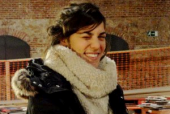Search
To search for an exact match, type the word or phrase you want in quotation marks.
A*DESK has been offering since 2002 contents about criticism and contemporary art. A*DESK has become consolidated thanks to all those who have believed in the project, all those who have followed us, debating, participating and collaborating. Many people have collaborated with A*DESK, and continue to do so. Their efforts, knowledge and belief in the project are what make it grow internationally. At A*DESK we have also generated work for over one hundred professionals in culture, from small collaborations with reviews and classes, to more prolonged and intense collaborations.
At A*DESK we believe in the need for free and universal access to culture and knowledge. We want to carry on being independent, remaining open to more ideas and opinions. If you believe in A*DESK, we need your backing to be able to continue. You can now participate in the project by supporting it. You can choose how much you want to contribute to the project.
You can decide how much you want to bring to the project.

Like someone breathing down one’s ear, is what the title of the second solo exhibition of Benja Sachau, in the gallery Soy Capitán, Berlin, feels like. “There were rumours” contains and drives the concept of this exhibition: for rumours, this troupe of possible truths, are located for most of us, in that scorned status of gossip amongst neighbours or the like, but could also be, and why not, the place for a just semi-certainty, a possible reality, one much more feasible, in fact, than any other absolute truth. Sachau deals with recurring subjects: what is truth (or why we think something is true); what is science; what is myth; where does fiction start; where does the real end… How stable is the truth in/of what we know?
The documentary “ Central Park Five” explains how, at the end of the 80’s, 5 minors from New York – blacks and Latinos – were wrongly put on trial, charged of raping a runner – a white woman – in Central Park. Forced by police to declare themselves guilty on the day they were detained, neither the DNA tests (that didn’t coincide), nor the statements, which didn’t concur, nor their repeated declarations of innocence after that first, coerced confession, were enough in the face of the media – and public opinion – hungry for culprits. Having spent seven years in jail, serving an unfair sentence in the flush of their adolescence, the confession of the real rapist, also imprisoned for other crimes, finally exonerated the young men. Why were they convicted with so many mistakes? How come the truth couldn’t be seen years before?
There Were Rumours manages to transmit, while barely judging it, this obstinacy of human kind, the imprint of the lie that is thought to be true, the triumphal place of the mistake in speculations that we are satisfied with, and that can ultimately determine the codes that we sanction, what we judge to be true.
Schlüssel (M16) and There Were Rumours, the piece that gives the title to the exhibition, at first glance look the same, but they are different. One reproduces a scientific text, the other a fragment from the Bible, and not just any old fragment: Matthew 24, 1-7, where Jesus warns of false prophets. To Whom it May Concern is a collage-archive, created out of the huge amount of correspondence generated after the passing of the Hale Bopp comet and its aftermath in apocalyptic, and paranoid conspiracy theories. Companion evokes once again this precise, symbolic geometry that inhabits all the works of the exhibition. A double star engraved (perforated) by hand into ceramic tiles, by Sachau himself, where the mark of obsession becomes even more tangible than in the rest of the pieces.
These are accompanied by three, wooden hula-hoops joined – stitched – together, with multi-coloured, nylon cords, drawn to the millimetre, by hand, Die Grosse Konjuntion (The great conjunction), and also a floating, heraldic trumpet, that also dominates the acoustic space. This is Beltone 222, and what we hear is the voice of Jim Jones, the spiritual leader of the largest collective suicide in history (900 people in one go), that took place only 35 years ago. Only in this case, the speech is manipulated so that only proper names are read out, taking the discourse to absurdity.
As absurd as all known truths, dogmas of faith, beliefs or “scientific-truth”, to which I might have tied myself, seem for a while, fully enjoying this suspension of belief generated by doubt. Benja Sachau recurs to the effective route of provoking an internal contradiction. However, the magnetism of this small exhibition is not due solely to the pieces it contains, its structure or the pleasant experience that it provokes, or perhaps that as well. It is due, to a great extent to the honesty with which the work is presented. I can’t seem to escape this self-analysis, to feel as my own this insistent movement towards paranoia, that being collective, – and of the past-, becomes my own and very present.

Marina spent the first two years of her life without saying anything: they told her parents that she was internalizing. And even though it’s a while now since she learnt to talk, she still needs to internalize. To then shake things up, question, order, disorder and celebrate. She finds politics in many places and has a special interest in all that’s subaltern, in the “commons”, and in the points where all this has an impact on creative expression.
"A desk is a dangerous place from which to watch the world" (John Le Carré)